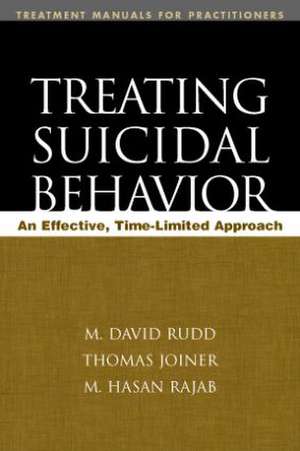Treating Suicidal Behavior: An Effective, Time-Limited Approach: Treatment Manuals for Practitioners
Autor M. David Rudd, Thomas E. Joiner, M. Hasan Rajaben Limba Engleză Paperback – 2 sep 2004
Grounded in a comprehensive model of suicidality, this volume describes an empirically supported cognitive-behavioral treatment approach. The clinician is guided to assess suicidal behavior and implement interventions tailored to the severity, chronicity, and diagnostic complexity of the patient's symptoms. Provided are session-by-session guidelines and clear-cut strategies for defusing the initial crisis; reducing suicidal behavior; restructuring suicide-related beliefs; and building interpersonal assertiveness, distress tolerance, problem solving, and other key skills. A special chapter covers risk assessment. Enhancing the book's utility are tables, figures, and sample handouts and forms, some of which may be reproduced for professional use.
Preț: 257.47 lei
Preț vechi: 271.03 lei
-5% Nou
Puncte Express: 386
Preț estimativ în valută:
49.27€ • 53.50$ • 41.39£
49.27€ • 53.50$ • 41.39£
Carte tipărită la comandă
Livrare economică 22 aprilie-06 mai
Preluare comenzi: 021 569.72.76
Specificații
ISBN-13: 9781593851002
ISBN-10: 1593851006
Pagini: 274
Dimensiuni: 152 x 229 x 21 mm
Greutate: 0.44 kg
Ediția:1
Editura: Guilford Publications
Colecția Guilford Press
Seria Treatment Manuals for Practitioners
ISBN-10: 1593851006
Pagini: 274
Dimensiuni: 152 x 229 x 21 mm
Greutate: 0.44 kg
Ediția:1
Editura: Guilford Publications
Colecția Guilford Press
Seria Treatment Manuals for Practitioners
Public țintă
Professional and Professional Practice & DevelopmentCuprins
I. Establishing a Foundation for Treatment
1. What Do We Really Know about Treating Suicidality?: A Critical Review of the Literature
2. A Cognitive-Behavioral Model of Suicidality
3. An Overview of the Treatment Process
II. Assessment and Treatment
4. Treatment Course and Session-by-Session Guidelines
5. The Evaluation Process and the Initial Interviews
6. Assessing Suicide Risk
7. Crisis Intervention and Initial Symptom Management
8. Reducing and Eliminating Suicide-Related Behaviors
9. Cognitive Restructuring: Changing the Suicidal Belief System and Building a Philosophy for Living
10. Skill Building: Developing Adaptive Modes and Ensuring Lasting Change
1. What Do We Really Know about Treating Suicidality?: A Critical Review of the Literature
2. A Cognitive-Behavioral Model of Suicidality
3. An Overview of the Treatment Process
II. Assessment and Treatment
4. Treatment Course and Session-by-Session Guidelines
5. The Evaluation Process and the Initial Interviews
6. Assessing Suicide Risk
7. Crisis Intervention and Initial Symptom Management
8. Reducing and Eliminating Suicide-Related Behaviors
9. Cognitive Restructuring: Changing the Suicidal Belief System and Building a Philosophy for Living
10. Skill Building: Developing Adaptive Modes and Ensuring Lasting Change
Notă biografică
M. David Rudd, PhD, is Professor of Psychology and Director of Clinical Training at Baylor University. He also maintains a part-time private practice. Dr. Rudd received his doctorate from the University of Texas at Austin and completed postdoctoral training at the Beck Institute in Philadelphia. He is the author of over 60 articles and book chapters.
Thomas E. Joiner, PhD, is Professor of Psychology and Director of the Psychology Clinic at Florida State University. He completed his doctoral training at the University of Texas at Austin. Dr. Joiner has authored over 100 articles and book chapters in the areas of depression, eating disorders, and suicidality.
M. Hasan Rajab, PhD, is Associate Professor in the Department of Psychiatry and Behavioral Science at Texas A&M Health Science Center. Dr. Rajab completed his doctoral training in biostatistics at Texas A&M University. He is the author of several articles addressing a range of issues in methodology and biostatistics.
Thomas E. Joiner, PhD, is Professor of Psychology and Director of the Psychology Clinic at Florida State University. He completed his doctoral training at the University of Texas at Austin. Dr. Joiner has authored over 100 articles and book chapters in the areas of depression, eating disorders, and suicidality.
M. Hasan Rajab, PhD, is Associate Professor in the Department of Psychiatry and Behavioral Science at Texas A&M Health Science Center. Dr. Rajab completed his doctoral training in biostatistics at Texas A&M University. He is the author of several articles addressing a range of issues in methodology and biostatistics.
Recenzii
Offer[s] clinicians for the first time a flexible and unique therapeutic program that is direct, time-limited, and buttressed by empirical support. Thus, clinicians facing the urgency of suicidal behavior can decide on the content and timing of interventions designed to eliminate suicidal behavior, and assess in an ongoing way the effectiveness of their efforts. Even if not often confronted with suicidal behavior, clinicians who become familiar with the procedures outlined in this manual will gain confidence in their ability to deal with suicidal crises. --From the Series Editor Note by David H. Barlow
This important book presents a short-term cognitive-behavioral treatment model that will be perused with interest by all contemporary suicidologists. The authors are exemplary scientist-practitioners within the field of psychology. They have produced a noteworthy, clinically useful contribution. --Edwin S. Shneidman, PhD., Professor of Thanatology Emeritus, University of California, Los Angeles
From premier scholar-clinicians, this remarkable book deftly guides the practitioner through the considerable challenges of working with suicidal patients. It is among the first (and only) comprehensive works of its kind. The authors manage to incorporate the wisdom of empirical science into a realistic and user-friendly practical approach, a rare accomplishment in the contemporary literature. The liberal use of intriguing case examples helps illustrate a broad range of theoretically grounded, intuitively appealing techniques and interventions that are essential to lifesaving clinical work. Written with great clarity, the book will be valuable for everyone from graduate students to mature clinicians. I am certain that the ripple of this book's impact on the field of clinical suicidology will be seen for many years to come. --David A. Jobes, PhD, Department of Psychology, The Catholic University of America; Past President, American Association of Suicidology
This book fills an important gap in the array of manualized treatment approaches that are currently available. Drawing on extensive research and experience in the treatment of suicidal individuals, the authors have fashioned a flexible, empirically validated, time-limited approach that will be welcomed by therapists of all persuasions. The book provides specific, detailed information on the 'why' and 'how' of a variety of integrated techniques. Replete with assessment forms, charts, and practical guidelines, this book will serve as a basic reference for therapists facing one of the most challenging clinical situations. --George A. Clum, PhD, Department of Psychology, Virginia Polytechnic Institute and State University
-This important book presents a short-term cognitive-behavioral treatment model that will be perused with interest by all contemporary suicidologists. The authors are exemplary scientist-practitioners within the field of psychology. They have produced a noteworthy, clinically useful contribution. --Edwin S. Shneidman, PhD., Professor of Thanatology Emeritus, University of California, Los Angeles
From premier scholar-clinicians, this remarkable book deftly guides the practitioner through the considerable challenges of working with suicidal patients. It is among the first (and only) comprehensive works of its kind. The authors manage to incorporate the wisdom of empirical science into a realistic and user-friendly practical approach, a rare accomplishment in the contemporary literature. The liberal use of intriguing case examples helps illustrate a broad range of theoretically grounded, intuitively appealing techniques and interventions that are essential to lifesaving clinical work. Written with great clarity, the book will be valuable for everyone from graduate students to mature clinicians. I am certain that the ripple of this book's impact on the field of clinical suicidology will be seen for many years to come. --David A. Jobes, PhD, Department of Psychology, The Catholic University of America; Past President, American Association of Suicidology
This book fills an important gap in the array of manualized treatment approaches that are currently available. Drawing on extensive research and experience in the treatment of suicidal individuals, the authors have fashioned a flexible, empirically validated, time-limited approach that will be welcomed by therapists of all persuasions. The book provides specific, detailed information on the 'why' and 'how' of a variety of integrated techniques. Replete with assessment forms, charts, and practical guidelines, this book will serve as a basic reference for therapists facing one of the most challenging clinical situations. --George A. Clum, PhD, Department of Psychology, Virginia Polytechnic Institute and State University
The text has numerous strengths including its theoretically grounded approach towards assessing suicide risk, clear session-by-session outlines of the implementation of both short- and long-term treatment strategies, and rich descriptions of empirical support for the techniques proposed....An exceptional guide to help clinicians effectively and efficiently treat suicidality, and the authors animate the test by providing a multitude of client worksheets, session transcripts, and flow charts. This book will definitely be on my list of recommendations for students and colleagues who want either to build or to strengthen their foundation in conducting cognitive therapy.
--Cognitive Behavioral Therapy Book Reviews, 7/28/2004ƒƒProvides practitioners with a working manual for dealing with the most serious, complex, and potentially lethal clinical problem found in any treatment and psychiatric rehabilitation setting....Should be on the shelf of all practitioners who interface and treat suicidal individuals.
--Psychiatric Rehabilitation Journal, 7/28/2004ƒƒA lifeline for both the patient and the therapist....Provides a rich web of techniques, advice, suggestions, and instructions to which the therapist and patient can hold onto in times of a life-and-death crisis without the therapist being overburdened by the sense of responsibility or the patient with uncontrollable anxiety....Very impressive.
--Death Studies, 7/28/2004ƒƒBy incorporating the clinical information contained in this book, clinicians will be better able to decide when and how to effectively intervene in the suicidal syndrome....This book is comprehensive, well-organized, and articulate.
--Journal of Nervous and Mental Disease, 7/28/2004Descriere
Grounded in a comprehensive model of suicidality, this volume describes an empirically supported cognitive-behavioral treatment approach. The clinician is guided to assess suicidal behavior and implement interventions tailored to the severity, chronicity, and diagnostic complexity of the patient's symptoms. Provided are session-by-session guidelines and clear-cut strategies for defusing the initial crisis; reducing suicidal behavior; restructuring suicide-related beliefs; and building interpersonal assertiveness, distress tolerance, problem solving, and other key skills. A special chapter covers risk assessment. Enhancing the book's utility are tables, figures, and sample handouts and forms, some of which may be reproduced for professional use.
















